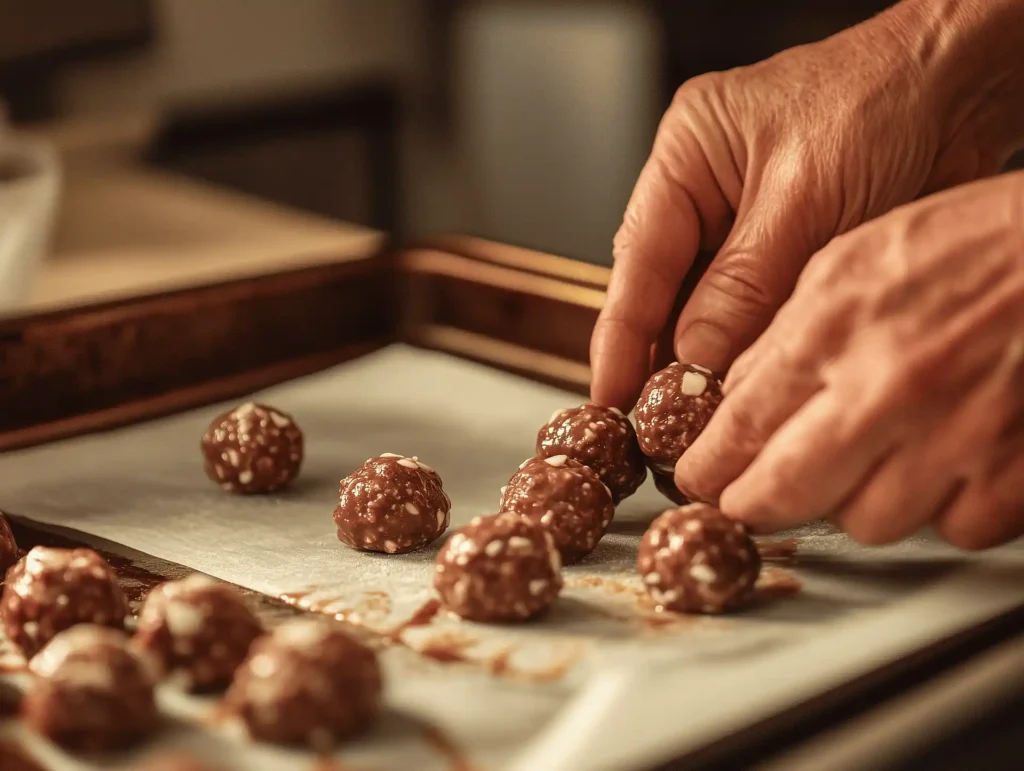Butterfinger balls are a delectable bite-sized dessert that combines creamy peanut butter, crushed Butterfinger candy bars, and chocolate into one irresistible treat. Perfect for parties, holidays, or just a sweet snack, they’re incredibly easy to make and even easier to devour.
This no-bake recipe has grown in popularity because of its simplicity and versatility. Whether you’re a seasoned chef or a novice in the kitchen, Butterfinger balls can be whipped up quickly without much effort. Their combination of crunchiness, sweetness, and creamy texture ensures they’re always a crowd favorite.
This guide will walk you through everything you need to know about making Butterfinger balls—from the ingredients and preparation to tips, creative variations, and even answers to common questions. Let’s dive in!
Ingredients for Butterfinger Balls
The beauty of Butterfinger balls lies in their simplicity. With just a handful of ingredients, you can create a dessert that tastes like it took hours to prepare. Here’s what you’ll need:
List of Essential Ingredients
- Butterfinger Candy Bars – These are the star of the show. Their signature crunch and caramelized peanut flavor provide the perfect foundation for this treat. You’ll need 4–5 full-size bars or about 1 cup of crushed candy.
- Creamy Peanut Butter – Adds a rich, smooth texture and complements the Butterfinger flavor. Use high-quality peanut butter for the best results.
- Powdered Sugar – Helps bind the mixture together while adding a touch of sweetness. Around 1–2 cups should suffice.
- Butter (Softened) – Brings everything together and enhances the creamy texture.
- Chocolate for Coating – Melted semi-sweet or milk chocolate chips work beautifully for the outer shell. White chocolate is a great alternative for a unique twist.
Substitutions and Variations
- Candy Bar Alternatives: If you don’t have Butterfinger candy bars, try other crunchy peanut-flavored candies, such as Reese’s or Heath bars.
- Nut-Free Version: Use sunflower seed butter instead of peanut butter and opt for nut-free candy alternatives.
- Low-Sugar Option: Substitute powdered sugar with a sugar-free sweetener, such as powdered erythritol.
- Dairy-Free Adaptation: Use dairy-free butter and chocolate for a lactose-free version.
Tips for Choosing the Best Ingredients
- Freshness is Key: Ensure that your Butterfinger candy bars are fresh and crunchy, as stale ones can affect the overall texture.
- High-Quality Chocolate: Choose premium chocolate for the coating to achieve a smooth, glossy finish that enhances the dessert.
- Room-Temperature Ingredients: Softened butter and room-temperature peanut butter are easier to mix and yield a smoother consistency.
By gathering these simple ingredients, you’re one step closer to creating a dessert that’s both impressive and indulgent. Let’s move on to the fun part: making the Butterfinger balls!
Step-by-Step Recipe

Making Butterfinger balls is a straightforward process that doesn’t require any baking. Follow these easy steps to create your delightful treat:
Preparing the Ingredients
- Crush the Butterfinger Bars: Begin by placing the candy bars in a zip-top bag and crushing them with a rolling pin until they reach a fine, crumbly texture. Alternatively, you can use a food processor for a finer consistency. Set aside a small portion for garnishing later if desired.
- Soften the Butter: Let the butter sit at room temperature for about 30 minutes, or microwave it for 10–15 seconds to soften it slightly (but avoid melting it completely).
Mixing and Shaping the Balls
- Combine the Base Ingredients: In a large mixing bowl, combine the crushed Butterfinger candy, softened butter, creamy peanut butter, and powdered sugar. Use a wooden spoon or spatula to mix until well blended. The mixture should be firm enough to hold its shape but not overly dry.
- Form the Balls: Using your hands or a small cookie scoop, roll the mixture into bite-sized balls, roughly 1 inch in diameter. Place the balls on a parchment-lined baking sheet to prevent sticking.
- Chill the Balls: Refrigerate the balls for about 20–30 minutes to firm them up before dipping them in chocolate.
Coating and Decorating
- Melt the Chocolate: In a microwave-safe bowl, melt the chocolate chips in 30-second intervals, stirring between each interval until smooth and fully melted. You can also use a double boiler for this step.
- Dip the Balls: Using a fork or dipping tool, carefully coat each ball in the melted chocolate, ensuring it’s fully covered. Let any excess chocolate drip off before placing the ball back on the parchment-lined baking sheet.
- Add Garnishes: While the chocolate is still wet, sprinkle the reserved crushed Butterfinger candy or other toppings (like chopped nuts or sprinkles) over the balls for extra flair.
- Set the Chocolate: Allow the chocolate coating to harden by placing the tray in the refrigerator for another 20–30 minutes.
Storing the Butterfinger Balls
Once the chocolate is set, transfer the Butterfinger balls to an airtight container. They can be stored in the refrigerator for up to two weeks or frozen for up to three months.
By following these steps, you’ll create a batch of Butterfinger balls that are as beautiful as they are delicious. Up next, we’ll cover some tips and tricks to perfect your technique.
Tips for Perfect Butterfinger Balls
While the recipe for Butterfinger balls is simple, a few tips and tricks can elevate your results, ensuring your treats are flawless every time.
Achieving the Perfect Texture
- Balance the Consistency: If your mixture is too sticky, gradually add more powdered sugar until it becomes easier to work with. Conversely, if the mixture is too dry, add a small amount of peanut butter to bring it back together.
- Chill Before Shaping: If the mixture feels too soft, refrigerate it for 10–15 minutes before rolling it into balls. This will make the process less messy and more manageable.
- Smooth Coating: For an even chocolate coating, ensure the balls are completely chilled before dipping. Warm or soft balls may fall apart during the dipping process.
Storage and Shelf Life
- Keep Them Fresh: Store Butterfinger balls in an airtight container in the refrigerator to maintain their texture and prevent the chocolate from softening.
- Freezing for Long-Term Storage: For extended shelf life, freeze the balls in a single layer on a baking sheet, then transfer them to a freezer-safe container or zip-top bag. Thaw in the refrigerator before serving.
- Serve at the Right Temperature: Butterfinger balls are best enjoyed slightly chilled but not icy cold. Let them sit at room temperature for a few minutes before serving.
Common Mistakes to Avoid
- Overheating the Chocolate: Chocolate that’s overheated can seize up and become clumpy. Melt it slowly in short intervals and stir frequently to maintain a smooth consistency.
- Skipping the Chill Step: Skipping the refrigeration step before dipping the balls in chocolate may cause them to fall apart or lose their shape.
- Overloading the Coating: Avoid dipping too many balls at once if your melted chocolate starts cooling down. Reheat the chocolate as needed to ensure a smooth coating.
Creative Twists and Variations
One of the best things about Butterfinger balls is how easily they can be customized. From seasonal twists to kid-friendly versions, the possibilities are endless. Here are some creative ways to make this recipe your own.
Adding a Twist: Unique Flavors
- Dark Chocolate Delight: Swap the milk or semi-sweet chocolate coating for dark chocolate to create a richer, more sophisticated flavor.
- Minty Fresh: Add a drop or two of peppermint extract to the chocolate before coating for a refreshing twist, perfect for holidays like Christmas.
- Coconut Crunch: Mix shredded coconut into the base mixture or sprinkle it on top of the chocolate coating for a tropical vibe.
- Salted Caramel Drizzle: After coating the balls in chocolate, drizzle them with salted caramel for a gourmet touch.
Kid-Friendly Variations
- Rainbow Sprinkles: Instead of crushed Butterfinger candy for garnish, use colorful sprinkles to make the treats more appealing to kids.
- Peanut-Free Option: Replace peanut butter with cookie butter or sunflower seed butter for a nut-free version that’s safe for school snacks.
- Fun Shapes: Use small cookie cutters to shape the mixture into hearts, stars, or other fun forms before coating in chocolate.
Seasonal and Holiday Ideas
- Halloween-Themed Treats: Use orange and black sprinkles or candy eyes to create spooky Butterfinger balls for Halloween parties.
- Festive Christmas Balls: Add crushed candy canes to the chocolate coating or sprinkle edible glitter for a holiday-themed dessert.
- Spring-Inspired Pastels: Dip the balls in white chocolate tinted with pastel food coloring for Easter or spring celebrations.
Custom Presentation Ideas
- Gift Boxes: Arrange the Butterfinger balls in decorative boxes or tins lined with parchment paper for a homemade gift.
- Party Platters: Create a dessert platter by pairing Butterfinger balls with other bite-sized treats like truffles or cookies.
- Personalized Wrappers: Wrap each ball in colorful foil or cupcake liners to make them look even more special.
FAQs
As simple as Butterfinger balls are to make, some questions often arise. Below are answers to the most frequently asked questions about this delightful treat.
Why Are My Butterfinger Balls Too Sticky?
If your Butterfinger balls are too sticky to handle, it’s likely because the mixture contains too much moisture or hasn’t been chilled enough. To fix this:
- Gradually add more powdered sugar to absorb the excess moisture.
- Chill the mixture for 15–20 minutes before rolling it into balls.
Can I Freeze Butterfinger Balls?
Yes, Butterfinger balls freeze beautifully, making them perfect for advance preparation. Follow these steps:
- Place the coated and fully set Butterfinger balls in a single layer on a baking sheet.
- Freeze them for 1–2 hours until solid.
- Transfer the frozen balls to an airtight container or freezer-safe bag.
They can be stored in the freezer for up to three months. Thaw in the refrigerator before serving.
Do I Need to Use Real Butterfingers?
While the classic recipe calls for Butterfinger candy bars, you can use alternatives if necessary. Similar crunchy, peanut-flavored candies like Reese’s Crispy Crunchy Bar or Heath bars work well. However, using authentic Butterfingers gives the most iconic flavor.
Can I Make These Without Peanut Butter?
Yes, you can substitute peanut butter with alternatives like almond butter, sunflower seed butter, or even cookie butter for a different flavor profile. Choose a substitute that’s creamy and easy to mix to maintain the correct texture.
How Long Do Butterfinger Balls Last?
When stored in an airtight container in the refrigerator, Butterfinger balls can last up to two weeks. For longer storage, freeze them as described above. Always keep them refrigerated to prevent the chocolate coating from melting.
What’s the Best Way to Melt Chocolate?
The best methods for melting chocolate are:
- Microwave: Heat in 30-second intervals, stirring in between, until smooth.
- Double Boiler: Place the chocolate in a heatproof bowl over a pot of simmering water, stirring constantly until melted.
Avoid overheating the chocolate, as this can cause it to seize or scorch.
Conclusion

Butterfinger balls are more than just a simple dessert—they’re a versatile and crowd-pleasing treat that’s perfect for any occasion. Their irresistible combination of creamy peanut butter, crunchy Butterfinger pieces, and a smooth chocolate coating makes them a guaranteed hit among kids and adults alike.
Whether you’re making them for a holiday gathering, a birthday party, or a mid-week indulgence, Butterfinger balls are a no-fuss, no-bake option that delivers maximum flavor with minimal effort. The recipe’s adaptability allows you to experiment with flavors, textures, and decorations, making each batch uniquely your own.
With the tips and tricks provided, even beginners can achieve professional-quality results. By incorporating creative variations, such as seasonal themes or nut-free alternatives, you can ensure everyone gets to enjoy these delightful treats.
Looking for more delicious ideas? Check out our Sourdough Garlic Bread for a savory treat, explore the unique flavors of Healthy Black Bean Noodles, or discover the secret behind Restaurant-Style Fluffy Pancakes.

